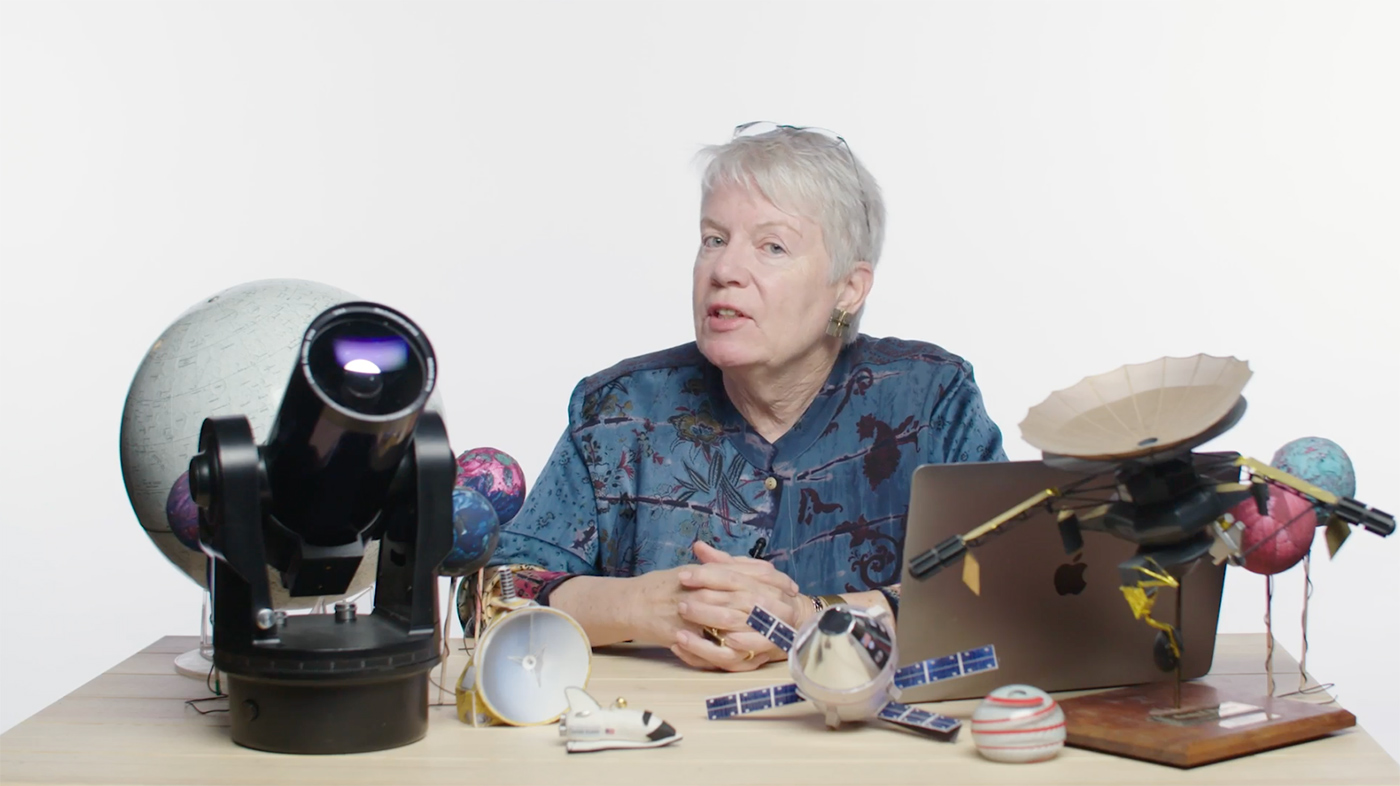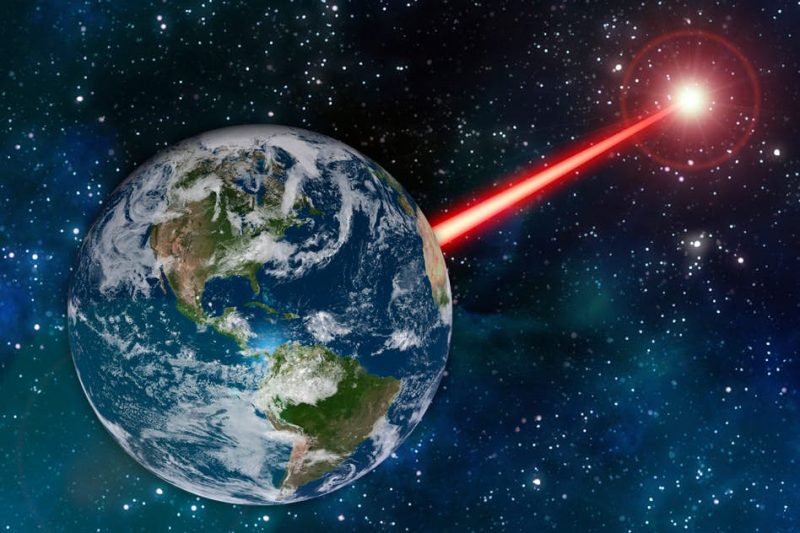
The SETI Institute’s Director of Education, Pamela Harman, joined Girl Scouts of the USA (GSUSA) at an event in Washington D.C. to discuss women's contributions to NASA. The event followed the launch of 42 new Girl Scouts badges for girls K-12. Three of the new badges are focused on space science and are part of SETI Institute’s Reaching for the Stars: NASA Science for Girl Scouts program. Harman spoke about the project in a GSUSA press release:
"Along with NASA, the SETI Institute has a rich history of working with Girl Scouts to give girls more opportunities to learn about space science. We are excited to continue advancing that cause," said Pamela. "With the latest Space Science badges, we can ignite the curiosity of girls at every level and equip them with the skills and confidence to become the next generation of female leaders in STEM."
Reaching for the Stars provides Girl Scouts with opportunities to engage in space exploration and astronomy in exciting and accessible ways. Learn more at SETI.org.
- PRNewswire: Girl Scouts and the SETI Institute Celebrate Apollo 11 Anniversary
- SETI.org: Girl Scouts USA and SETI Institute Join Capitol Hill Panel to Discuss Engaging Girls in Space Science
 Forbes Asks: Can We Decode an Extraterrestrial Message?
Forbes Asks: Can We Decode an Extraterrestrial Message?If we were to pick up a message from extraterrestrials, how on Earth would we interpret it? Scientists searching for evidence of extraterrestrial life have given it some thought. Seth Shostak, a longtime alien hunter and SETI Institute's Senior Astronomer, shared some insights with Forbes. "People think we're looking for the value of pi, the Fibonacci series, prime numbers, Shakespeare sonnets, whatever. But none of that is true.”
Radio SETI experiments typically look for narrow-band signals – radio emissions that only cover a narrow part of the radio spectrum, a hallmark of a built transmitter. Natural cosmic phenomenons that generate radio signals spread their static more diffusely through the spectrum. Should a signal be detected, protocols for confirmation would be followed to confirm its authenticity and make the data widely available. The next challenge would be analyzing and understanding the message.
The Forbes article also noted that SETI Institute research scientist Laurence Doyle has been exploring the challenge by delving into animal communication. Doyle developed an algorithm capable of applying a linguistic model known as Zipf’s law to adult bottlenose dolphin sonic communications, revealing markers of syntax. This tool could be used to measure the communication complexity of any signals suspected to be of artificial origin.
- Forbes: How Could We Decode A Message From Extraterrestrials?
- SETI.org: Humpback Whale Communication and the Search for Extraterrestrial Intelligence
 How the Moon Landing Changed Our View of Extraterrestrials
How the Moon Landing Changed Our View of ExtraterrestrialsThe historic Apollo 11 moon landing left its mark on the human imagination as it ushered in a new era of space exploration. Seth Shostak, the SETI Institute’s Senior Astronomer, spoke to Live Science about the impact landing people on the moon had on the public’s view of searching for extraterrestrial life:
“I think the moon landing did affect the public perception of extraterrestrial life. Up until then, rockets and so forth were just science fiction. But the Apollo missions showed that you could travel from one world to another on a rocket — and maybe aliens could, too. I think that, from the public's point of view, this meant that going to the stars wasn't always going to be just fiction. Suddenly, the universe was a little more open.”
Although scientists knew life was unlikely to be found on the moon, the public fascination with alien life has only grown since that fateful day in 1969. Shostak notes, "Today, about 30 percent of the public thinks the Earth is being visited by aliens in saucers, despite the evidence of that being very poor… I think the moon landing had something to do with that."
 Jill Tarter Fields Twitter’s Most Pressing Alien Questions
Jill Tarter Fields Twitter’s Most Pressing Alien QuestionsJill Tarter, astronomer and Chair Emeritus for SETI Research at the SETI Institute, appeared in a Wired video to answer questions from Twitter about aliens. One user wanted to know why we haven’t found intelligent extraterrestrial life yet:
“Really interesting question; the answer is we've hardly begun to look. Let me give you an example. If that volume of space we need to explore is equal to the volume of all the world's oceans, in 50 plus years, we've observed only about one hot tub's worth of the ocean. Maybe it's not so surprising that we haven't detected anything yet. We need to think in terms of cosmic times and not human lifetimes before we decide we're alone.”
Watch the rest to hear Tarter's answers on whether math is a universal language, if the military should develop a defense against alien invaders, and extraterrestrial etiquette.
- Wired (Video): Astronomer Jill Tarter Answers Aliens Questions from Twitter
 VERITAS and Breakthrough Listen Announce New Search for Optical Signals
VERITAS and Breakthrough Listen Announce New Search for Optical SignalsBreakthrough Listen and the VERITAS Collaboration (Very Energetic Radiation Imaging Telescope Array System) recently announced a new partnership. The goal is to enhance the search for optical technosignatures – signals of extraterrestrial origin. Breakthrough Listen is part of the Breakthrough Initiatives, a multi-pronged science program founded by Yuri Milner to search for extraterrestrial intelligence. Breakthrough Listen has focused its efforts on radio signal searches. Historically, radio searches have been a staple of the SETI field, on the basis that since humans use radio for communications, so too might an alien civilization.
Additionally, a strong radio signal is capable of traveling the vast distances between stars. VERITAS allows the search to broaden by searching for visible signs, such as laser flashes, which similarly could indicate communication over incredible distances in space. EarthSky interviewed Frank Drake who pioneered SETI research and is Chair Emeritus of the SETI Institute’s Board of Trustees. "One great advantage of optical SETI is that there’s no terrestrial interference. It’s an exciting new field.”
Andrew Siemion, a principal investigator for the Breakthrough Listen program and Bernard M. Oliver Chair of SETI Research at the SETI Institute, offered some insight on the project via U.C. Santa Cruz:
“Breakthrough Listen is already the most powerful, comprehensive, and intensive search yet undertaken for signs of intelligent life beyond Earth. Now, with the addition of VERITAS, we’re sensitive to an important new class of signals: fast optical pulses. Optical communication has already been used by NASA to transmit high definition images to Earth from the moon, so there’s reason to believe that an advanced civilization might use a scaled-up version of this technology for interstellar communication.”
Optical SETI offers a new frontier in the search for a technologically advanced life beyond Earth. LaserSETI is an initiative of the SETI Institute. It's a low-cost instrument designed to perform the first all-sky, all-the-time surveys for laser flashes that could indicate an extraterrestrial signal (or as-yet-unknown cosmic phenomena). LaserSETI recently announced the site for its first installation.
- EarthSky: Breakthrough Listen’s new search for alien lasers
- U.C. Santa Cruz News Center: Breakthrough Listen launches new optical search with VERITAS Telescope Array
- Technical.ly: U.D. professor to co-lead SETI project seeking a new class of signals
- Phys.org: Breakthrough Listen launches new optical search with Arizona's VERITAS telescope array
- SETI.org: Site for First LaserSETI Observatory Identified
 Jason Wright on the Drake Award and Viral Joke to “See Them Aliens”
Jason Wright on the Drake Award and Viral Joke to “See Them Aliens”Penn State astronomer Jason Wright knows a thing or two about searching for extraterrestrials. Wright is the 2019 recipient of the Drake Award, named for SETI pioneer Frank Drake and bestowed by the SETI Institute to honor contributions to astrobiology through scientific research and space exploration. Still, he’s not too keen on the viral internet joke to “raid” Area 51 to look for aliens. In a recent Q&A for LiveScience, Wright shared his thoughts on the public’s renewed interest in Area 51:
I was completely unaware of this "raid" until you brought it to my attention! I work in SETI, the scientific search for extraterrestrial intelligence, and believe me, no one wants to find evidence of extraterrestrial life more than those of us in this field. We scour the skies for evidence of such extraterrestrial technologies with some of the most advanced equipment in the world for understanding what's going on in the sky, and we haven't found anything compelling yet… I don't know very much about Area 51, but I can say that the intense interest in the goings on there related to aliens reveals a deep public interest in what kinds of life might exist elsewhere in the universe.
Wright also elaborated on winning the 2019 Drake Award and what it meant to him as a researcher:
The Drake Award is awarded occasionally by the SETI Institute, a research center dedicated to understanding humanity's place in the universe. I see this award as validation of my work to help elevate the field of SETI as an academic discipline and to persuade Congress, NASA, and the public that it is worthy of public investment. It is, after all, the scientific approach to answering one of the most profound questions ever asked: Is Earth life unique? Or are there other beings like us out there in the universe?
- Live Science: Alien Hunter Explains Why He Won't Be Going to Area 51 to Look for ‘Little Green Men'
- SETI.org: SETI Institute Names Jason Wright as Recipient of the 2019 Drake Award
In last week’s episode, reconnect with your inner social animal with Let's Stick Together. In our previous week’s episode, discover new ways to appreciate math in Math’s Paths.
Last time on Facebook Live, NASA FDL Exploration & Ideation Director Jonathan Knowles interviewed FDL Floods researchers. Videos of all past Facebook Live events are on our Facebook page: https://www.facebook.com/SETIInstitute/





